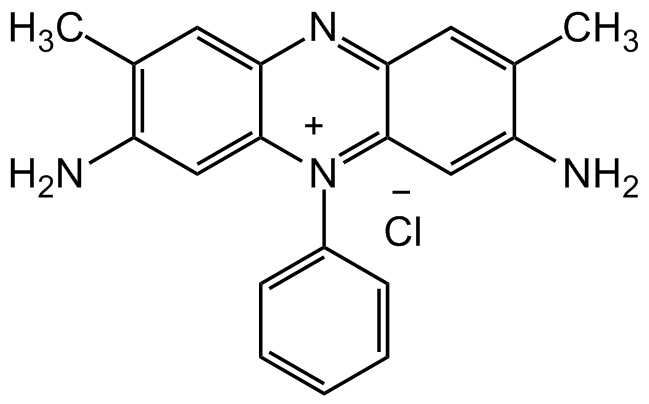Gram's Safranin Solution
| Code | Size | Price |
|---|
| CDX-G0061-L250 | 250 ml | £41.00 |
Quantity:
| CDX-G0061-LL25 | 2.5 l | £194.00 |
Quantity:
Prices exclude any Taxes / VAT
Overview
Regulatory Status: RUO
Shipping:
Ambient
Images
Documents
Further Information
Alternate Names/Synonyms:
Safranin O Solution; Safarin T Solution
Appearance:
Red to very dark red liquid.
CAS:
477-73-6
EClass:
32160000
Form (Short):
liquid
GHS Symbol:
GHS02
Handling Advice:
Protect from light and moisture.
Hazards:
H226
InChi:
InChI=1S/C20H18N4.ClH/c1-12-8-17-19(10-15(12)21)24(14-6-4-3-5-7-14)20-11-16(22)13(2)9-18(20)23-17;/h3-11H,1-2H3,(H3,21,22);1H
InChiKey:
OARRHUQTFTUEOS-UHFFFAOYSA-N
Long Description:
Chemical. CAS: 477-73-6. Formula: C20H19ClN4. MW: 350.84. Synthetic. Gram Safranin Solution is a reagent recommended for use in qualitative procedures to differentiate gram-negative from gram-positive organisms. The Gram staining allows a fast differentiation of bacteria in Gram-positive and Gram-negative. The mureine structure of the bacteria walls is the basis of the color affinity. Bacteria will be stained with Gram's crystal violet solution - an aniline dye - in the first step. After the treatment with iod solution, a dye-iod complex will form. During the decolorizing step, this complex stays in the multilayer mureine structures of the Gram-positive bacteria and they will appear blue. Gram-negative bacteria have a monolayer mureine structure only, the dye-iod complex does not stay bound to the cellwall, they will be decolorized. Gram-negative bacteria will be counterstained by safranin solution and appear orange.
MDL:
MFCD00011759
Molecular Formula:
C20H19ClN4
Molecular Weight:
350.84
Package Type:
Plastic Bottle
PG:
III
Product Description:
Gram Safranin Solution is a reagent recommended for use in qualitative procedures to differentiate gram-negative from gram-positive organisms. The Gram staining allows a fast differentiation of bacteria in Gram-positive and Gram-negative. The mureine structure of the bacteria walls is the basis of the color affinity. Bacteria will be stained with Gram's crystal violet solution - an aniline dye - in the first step. After the treatment with iod solution, a dye-iod complex will form. During the decolorizing step, this complex stays in the multilayer mureine structures of the Gram-positive bacteria and they will appear blue. Gram-negative bacteria have a monolayer mureine structure only, the dye-iod complex does not stay bound to the cellwall, they will be decolorized. Gram-negative bacteria will be counterstained by safranin solution and appear orange.
Purity:
for microscopy
Signal word:
Warning
SMILES:
CC1=C(N)C=C([N+](C2=CC=CC=C2)=C(C=C(N)C(C)=C3)C3=N4)C4=C1.[Cl-]
Solubility Chemicals:
Soluble in ethanol.
Source / Host:
Synthetic.
Transportation:
Non-hazardous
UNSPSC Category:
Fluorescent Reagents
UNSPSC Number:
41105331
Use & Stability:
Stable for at least 2 years after receipt when stored at RT.
References
(1) E. Adams; Stain Technol. 50, 227 (1975) | (2) R. Coico, et al.; Curr. Protoc. Microbiol. Appendix 3-3C (2005)



